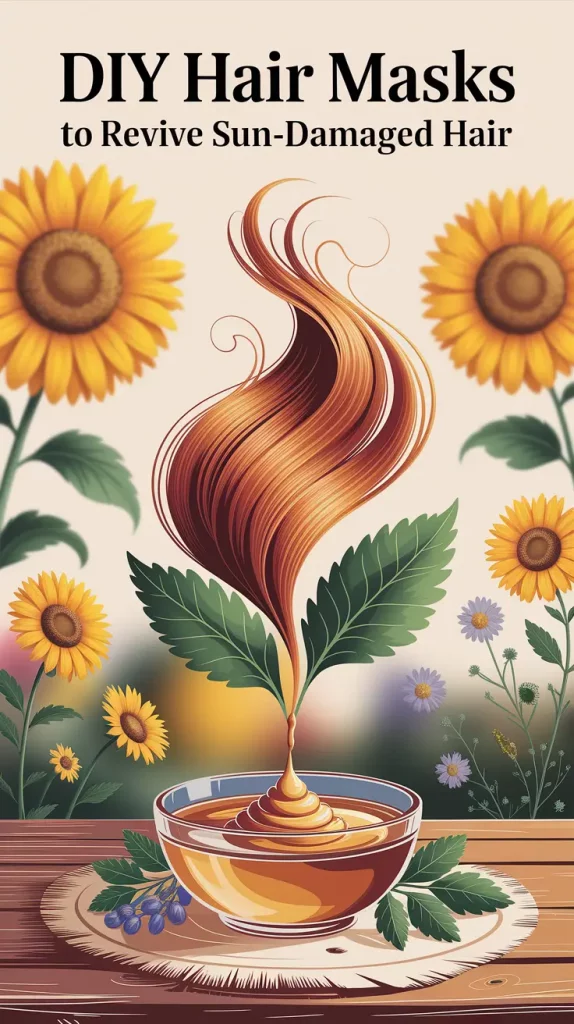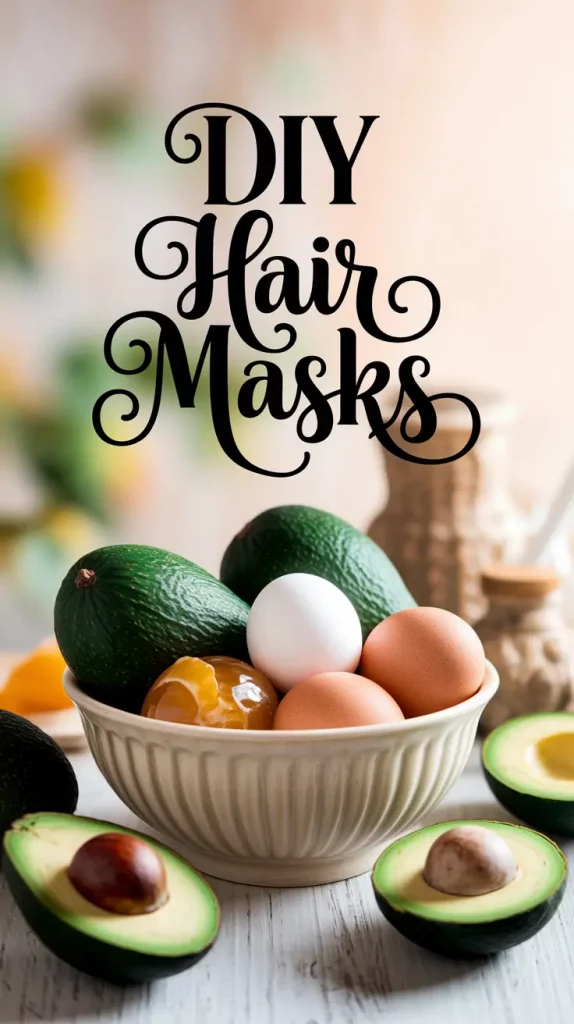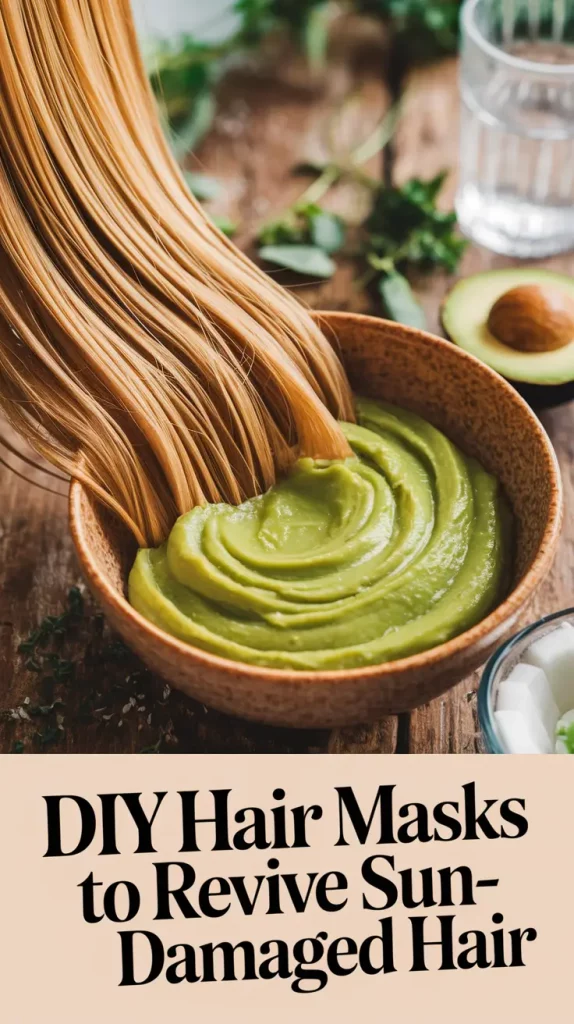DIY Hair Masks to Repair Sun-Damaged Hair in 2025: Natural Recipes and Pro Tips
As of 2025, more than 70% of individuals living in California, Texas, and Florida report their hair is dry, brittle, or faded, creating a worrying trend. From heatwaves to high UV indexes, our hair becomes damaged a lot faster than we think.
If your hair feels like straw or appears colorless and lifeless, don’t worry, you’re not alone facing these problems. The sun, salty ocean water, and chlorine work too well together to destroy your hair’s natural protective layer, causing it to be vulnerable to “damage” and “split ends.” The good news is you don’t have to spend money on salons to fix it.
In this guide, I will show you how to create simple DIY hair masks to revive and restore the sun’s harsh impact on our hair in 2025, understand the “why” behind the damage, and learn expert tips on how to rejuvenate your hair naturally, affordably, and effectively.
Who is this article relevant to?
- Residents living in sunny or coastal areas.
- Individuals with colored, curly, bleached, or fine sparse hair.
- People seeking haircare remedies that are inexpensive, chemical-free, value-effective, and easy.

What are the Sun’s Most Damaging Aspects For Hair In 2025?
What Remains Different About Today’s Environment?
The sun’s rays have always been harmful to hair, but some lifestyle choices have worsened the situations. “Like your skin, hair is made up of layers. Each of these is particularly vulnerable to Solar Ultraviolet Radiation, the strongest type of UV light, and, likewise, gets broken down by it.” UV radiation is harmful, but so is pollution; and increases in either has proven to be a problem. Recent research reveals that the average UV exposure in the United States has increased by 12% over the last decade.
To make matters worse, higher air temperatures, increased levels of humidity, and an alarming increase in pollution—hair faces an onslaught of environmental aggressors at every moment.
Top Signs of Sun-Damaged Hair
- Dryness and lack of shine
- Rough texture that tangles easily
- Breakage when brushing or styling
- Color fading (especially blondes and redheads)
- Frizz and split ends even after washing
Does this sound familiar? Then keep reading.
How to Repair Sun-Damaged Hair: Core Principles
Hydration and Nutrition Go Hand in Hand
Just like the rest of the body, hair also needs moisture and nutrition. Absorbing UV rays will remove oil and protein from the hair strands which means any needed masks must restore hydration and fortifying fats, proteins, vitamins, and amino acids restore structure.
Think hydration = softness. Nutrition = strength. Balance is the key.
3-Step Hair Rehab Process
- Gentle cleansing – Using a sulfate-free shampoo is ideal so no additional damage will occur.
- Repair treatment – Mask the hair and scalp with high fatty acid rich antioxidant masks.
- Seal the deal – Leave-in protectants to seal in moisture paired with cool rinses complete treatment.
Use these tips to optimize your hair and scalp masks, apply to hair damp, not sopping for the greatest absorption.

Best Masks For Sun-Damaged Hair And Reviving Them
Magic happens here! These can be made with ingredients that are common in nearly every American grocery store, or can be ordered online.
1. Avocado & Coconut Oil Mask (dry, thick or curly hair)
Why it works: Avocado is enriched and dense with biotin and vitamin E which are proven aids for hair. Also, coconut oil has the ability to penetrate deep into the hair shaft preventing protein loss.
Ingredients:
- ½ ripe avocado
- 2 tbsp coconut oil (unrefined)
- 1 tsp honey (optional for extra shine)
Instructions:
Mash all ingredients until smooth. Apply from mid-length to ends. Cover with a shower cap and leave for 30 minutes. Rinse and shampoo.
2. Aloe Vera & Honey Cooling Mask (for thin, bleached, or sensitive scalps)
Why it works: Aloe soothes sunburned scalps and hydrates. Honey is a natural humectant that attracts moisture.
Ingredients:
- 2 tbsp aloe vera gel (pure)
- 1 tbsp raw honey
- 1 tsp olive oil
Instructions:
Mix well and apply to scalp and hair. Massage gently and leave for 20 minutes. Rinse with cool water.
3. Banana & Greek Yogurt Repair Mask (for damaged or brittle hair)
Why it works: Bananas are rich in potassium and antioxidants, while yogurt adds protein and lactic acid for gentle exfoliation.
Ingredients:
- ½ ripe banana
- 2 tbsp full-fat Greek yogurt
- 1 tsp argan oil or jojoba oil
Instructions:
Blend until creamy. Apply evenly through the hair. Wrap in a warm towel. Wait 25–30 minutes before rinsing.
4. Egg & Olive Oil Strengthening Mask (for dull, weakened strands)
Why it works: Eggs deliver essential proteins; olive oil softens and seals split ends.
Ingredients:
- 1 egg yolk
- 2 tbsp olive oil
- 1 tbsp water (to thin the mix)
Instructions:
Whisk ingredients. Apply evenly. Leave for 20 minutes—no longer, or it may harden. Rinse with cold water to avoid cooking the egg!

📊 Comparison Table: Which Mask Is Right for You?
| Mask Name | Best For | Time | Use Frequency |
|---|---|---|---|
| Avocado & Coconut | Dry, curly, thick hair | 30 min | 1-2x/week |
| Aloe & Honey | Thin, bleached, sensitive | 20 min | 2x/week |
| Banana & Yogurt | Brittle, overprocessed | 25 min | Weekly |
| Egg & Olive Oil | Fine, dull strands | 20 min | Every 10 days |
Expert Tips to Maximize Mask Effectiveness
Want better results? It’s not just what you put on your hair—but how.
- Always use masks on clean, towel-dried hair
- Wrap hair in a warm towel to open the cuticle
- Rinse with cool water to seal moisture in
- Avoid heat styling for at least 24 hours after masking
- Use a silk pillowcase to prevent overnight damage
Rhetorical check-in:
Have you ever tried leaving a mask overnight? It could be the game-changer your hair needs—just make sure to wrap it properly.
Common Mistakes When Using DIY Hair Masks
Even natural remedies need the right technique. Avoid these slip-ups:
- Overuse: More isn’t better. Too-frequent masks can lead to buildup.
- Wrong ingredients: Not every oil suits every hair type. (Example: Castor oil is too heavy for fine hair.)
- Skipping patch test: Essential if using essential oils or honey.
- Applying to dirty hair: Dirt and oils block nutrient absorption.
💬 What’s the biggest mistake you’ve made with a DIY mask? Share your story below!
Trending Hair Recovery Solutions in 2025
The natural beauty trend is only growing. Here’s what’s making waves this year:
- SPF-infused hair mists are becoming mainstream in brands like OUAI and Sun Bum
- Seawater minerals and kelp extracts are replacing silicones
- Hybrid products (mask + leave-in) are trending on TikTok with #HairTok enthusiasts
📰 Latest buzz: Ulta and Sephora now carry DIY hair mask kits tailored to your hair type!
Final Thoughts: Bring Your Hair Back to Life—Naturally
Let’s recap the essentials:
- Sun, salt, and heat wreak havoc on your hair—but DIY masks can reverse the damage.
- The best masks combine moisture + protein + fats.
- Choose ingredients based on your hair type and lifestyle.
- Follow up with gentle care and UV protection.
- Be consistent—but don’t overdo it.
🌿 Healthy hair starts at home—and often, in your kitchen.
💬 Tell Us:
Have you tried any of these hair masks? Which one worked best for you? Or maybe you have a secret recipe of your own—drop it in the comments!
📲 Don’t forget to share this article with a friend who’s battling post-summer hair drama!

